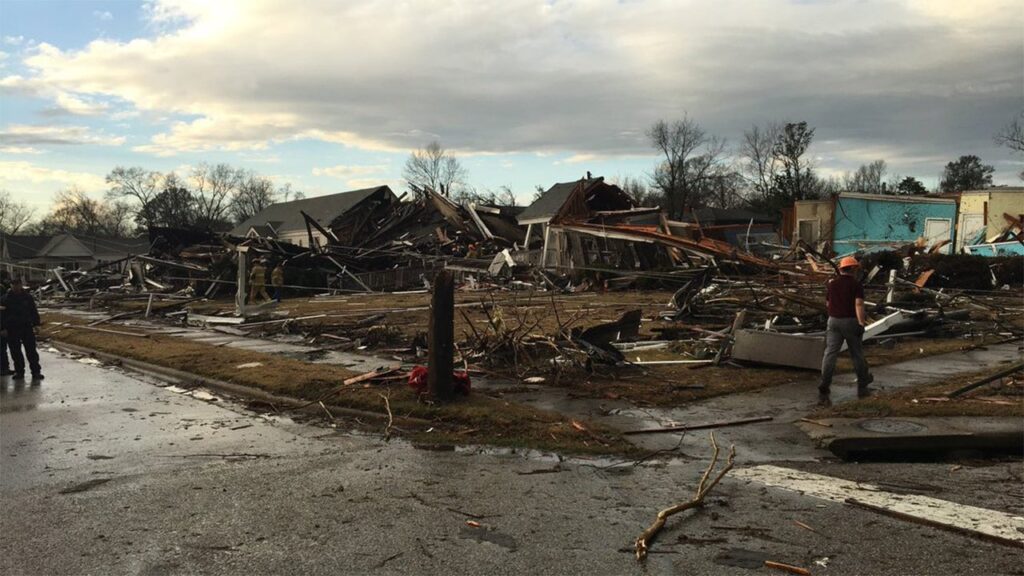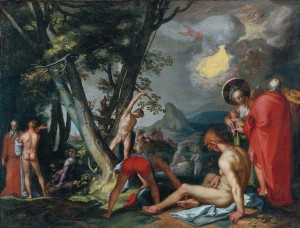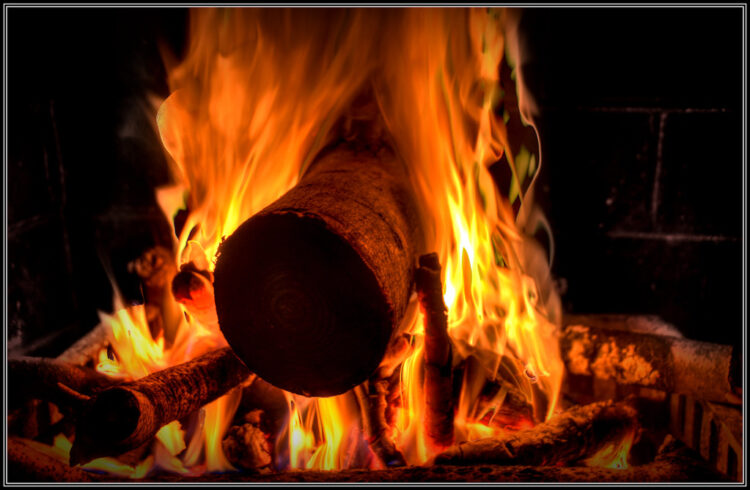Sermon for The Baptism of Our Lord.
Based on readings in the Three-year Revised Common Lectionary.
Year A: Isaiah 42:1-7; Psalm 29; Acts 10:34-38; Matthew 3:13-17
Year B: Genesis 1:1-5; Psalm 29; Acts 19:1-7; Mark 1:4-11
Year C: Same as Year A except the Gospel of Luke 3:15-16, 21-22
Weather-related catastrophes have become more frequent occurrences in recent years. They make news headlines and are at the top of TV news broadcasts.

Many believe that the hurricanes, tornados, big snows, heavy rains, floods, droughts and forest fires we have been experiencing in different parts of the world are related to climate change. To these can be added earth quakes, volcanic eruptions, and tsunamis. It seems that the Earth is convulsing.

Weather-related catastrophes have been consistently reported because they are major human and ecological disasters. It seems that the wild fires in Australia and California are events of apocalyptic proportions.

The elements of water, wind, and fire cause deaths and destruction of property, the upending of lives, and massive disruption of travel. This should remind us that even the sacrament of Holy Baptism that deals with the sign of water and the symbols of wind and fire is not as safe as we might assume – although, admittedly, we have to stretch our imaginations to see our parish baptisms of infants being included in the death and resurrection rhetoric about Baptism in Scripture and tradition. (Note the depiction of the river also as the grave in the Orthodox icon of the Baptism of Christ above this article.)

Fires, winds, and floods are devastating. Yet the world as we know it emerged from such elements. The earth itself is still a hot molten mass in its core and is still predominantly covered by the waters of the oceans. When the story of Genesis begins there is not nothing, as we often assume with our doctrine of creatio ex nihilo (creation out of nothing). The earth already existed as a formless void with darkness covering the deep. The wind of God swept over the waters so that land would emerge. And light shown in the darkness as what we now know as the rotation of the planet creating day and night was stabilized. Evening and morning was established—the time of day, a liturgical day that begins with Vespers in the evening. “There was evening, and there was morning,” a day. Yes, there’s a liturgical character to the creation story in Genesis 1 that climaxes in the establishment of the Sabbath on the seventh day. Liturgy brings order out of chaos. It regulates the use of the elements and the times of the day. So it is safe, even though scary, to enter the waters of Holy Baptism.

The fact that we have survived the journey to the font in the Christian assembly should be cause for rejoicing and thanksgiving, but not for presuming that we will always come out unscathed in the catastrophes of life in this world, including the devastations of nature and the terrors of history.
The psalmist reminds us that the world is not a tame place. The voice of creation’s Lord thunders over mighty waters, breaks the cedars of Lebanon, flashes forth flames of fire, and shakes the wilderness of Kadesh. People get hurt in these natural upheavals. We must acknowledge that faithful Christians too have been swept away in the floods, crushed in the tornadoes, and consumed in fire and smoke along with others. Who is saved and who isn’t is an imponderable mystery that has caused many people to lose their faith. If God saved one family, as the survivors often say with thanksgiving, why did he not save the family across the street?
The Lord God tamed the waters to bring forth land and vegetation and animals and humans. In the more “earthy” creation story in Genesis 2 the Lord God begins with the creation of Adam from the dry ground, first causing a spring of water to well up in the desert so that the Lord God could make clay to form the man. The Lord also breathed the breath of life into the man to make him a living being. The breath of God given to Adam is given to all humankind. Isaiah says that “God, the Lord, who created the heavens and stretched them out, who spread out the earth and what comes from it,…gives breath to the people upon it and spirit to those who walk in it” (Isaiah 42:5). This is a spirit that always needs to be stirred up and strengthened. This happens in Holy Baptism and its repeated affirmations.

The Jewish people were people of the land. They were not a water-loving people. They associated water with dangers, with storms and sea monsters and the threat of death. But salvation has always depended on going through the threatening flood. Look at the double edged symbolism of water in the stories of the Bible.
Noah’s flood, a story evoked by the presence of the dove in the story of Jesus’ baptism, is both a story of the near annihilation of the world, and a story of the salvation of humanity and the animal kingdom through the ark.
The Red Sea first stood as a barrier to the escaping Hebrew slaves who were trapped between the threat of drowning and the threat of a hostile army, but it becomes the image of salvation as God opens a way of safety that goes right through the midst of the waters to dry land.
The Jordan River too stood as a barrier between the people wandering in the wilderness and the milk and honey of the promised land. It wasn’t as big a body of water as the Red Sea, but it could bog down the Israelites if the Canaanites joined together to mount an assault to keep these migrants from crossing over. Yet it too becomes a river that God opens as a way of salvation for his people, and a safe journey to their new homeland.
These are all types of baptism in Israel’s history. These stories form the narrative of salvation history recounted in the thanksgiving over the water in the liturgy of Christian baptism. We include these images in the prayer of blessing of the water in the liturgy of Holy Baptism to remind us as a people what waters we have been through before.
In the river Jordan that served as a demarcation between the promised land and the land beyond the Jordan, John the Baptist appears and puts people into the water — including his cousin Jesus who insisted on identifying with the people of Israel in their confession and forgiveness of sins. The water is a sign of death, but also of life and cleansing.

When Jesus comes to his cousin John for baptism, John points to him as the One whose sandals he is not worthy to untie, one who will baptized with the Holy Spirit and with fire. The evangelists represent the Spirit coming down on Jesus as…a pigeon.
But Jesus’ baptism is not completed by John. He had another baptism to go through — a baptism in blood. He would eventually be linking his baptism with his impending death at the hands of the leaders of the people who thought their job was to purge Israel of God’s enemies. “Can you be baptized with the baptism into which I am soon to be baptized?” he asks his bewildered disciples.
On the Day of Pentecost when the disciples are baptized with the Holy Spirit, the Holy Spirit does indeed come as a roaring wind and tongues of fire. But far from being fires of destruction, these tongues of fires unleash the disciples’ tongues so that they can speak God’s message of salvation to those who had come to Zion and gathered in Jerusalem for the festival. They had come from east and the west, north and the south. The violent wind that the psalmist identifies as God’s voice of thunder that can strip forests bare becomes the energy of God that sends the Apostles out into the streets to proclaim God’s message of salvation for all people, exhorting them to repent and be baptized.
The baptism with water and the Holy Spirit spills across every boundary or border. The fellowship of the Christian Church is not restricted within national boundaries along which we want to build higher walls to keep out immigrants and refugees. We see that in the reading from Acts 19 in which twelve new disciples of Jesus were made in Ephesus in Asia Minor by being baptized in the name of Jesus. Their speaking in tongues was a sign that they had received the baptism of Jesus; their baptism by John was a purification that did not convey the Holy Spirit. The fellowship of the baptized, formed by water and the Spirit, is extended from nation to nation and reaches now around the world, although not without hostility and resistance from those who would push back the gospel of Jesus, especially today in some of the oldest Christian settlements in the world in Egypt and the Middle East.
Those who are given the sign of the cross in Baptism often bear the cross of persecution and suffering. Some are taken as sheep to be slaughtered; others are not. Nor are we any the wiser about why some survive the devastations of nature and some don’t. Coming to faith is no insurance policy against the swath of persecution or the hazards of life in this world.
But we have already entered into death and resurrection in the baptismal font and we aren’t afraid of what we face in life. We plunge into life—like the Greek boys who dive into the waters to retrieve the cross on the Epiphany Day blessing of the waters and discover what a profound renewal of baptism this experience is. In life they are to follow the cross, even as they followed it into the depths of the sea—that formless void to which the earth sometimes threatens to return.

I can’t tell you that following the cross of Christ keeps you safe from all disasters. I can only tell you that if you are willing to follow Jesus into the danger zones, to follow him even when he walks through the flames of hostility and passes through the depths of death and burial, and if you are willing to allow him to teach you how even suffering and death can be a redemptive gift of healing and liberation, then the truth of faith will begin to emerge for you.
God does not fail us in the things that matter. The God who tamed the waters of chaos with the wind of the Spirit does not allow the floods and the winds and the flames to have the last word. They are harnessed as the elements of the sacrament of Holy Baptism. Salvation is created in the waters of rebirth and in the winds and fires of God the Holy Spirit making space for the flourishing of new life in a new creation emerging in the midst of the old one that is consumed by fire, drowned with water, and breathed to resurrection by the God of life. Alleluia! Praise the Lord!” Amen.
Pastor Frank Senn





